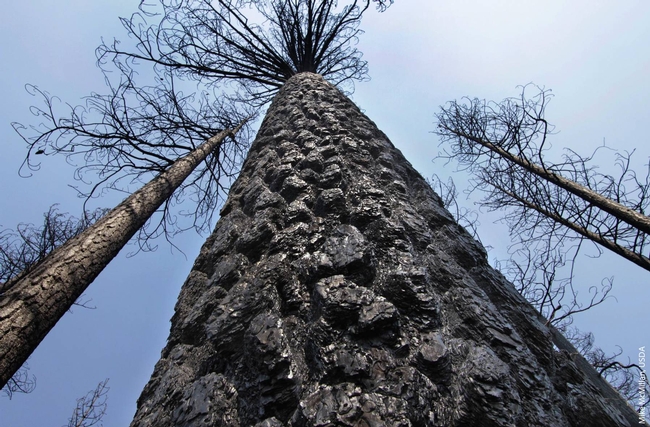Burned forestland needs erosion protection
“The loosened soil and ash can move quickly under proper storm conditions,” said Greg Giusti, a UC ANR Cooperative Extension forestry advisor. “Property owners should take immediate action.”
A longstanding practice in the West has been spreading grass seed after a fire, however, the seed is slow to germinate and grow during the cold months that follow fire season.
“Seeding is generally ineffective,” Giusti said. “The seed simply moves and erodes with the soil and ash following an initial rain event.”
After losing a home, homeowners may feel the need to clean up their property. However, leaving woody debris, downed trees and limbs will arrest soil movement. Stumps and standing dead trees also help protect the soil.
“The roots are still in the soil and will help hold it in place,” Giusti said. “As long as they don't pose a danger, trees should be left in place.”
Spreading rice straw or weed-free hay on the ground is another way to protect the soil from erosion. Whole bales of hay can be placed in natural drainages to slow water movement and reduce erosion. Straw wattles – long tubes of compressed straw encased in jute or another material – may be laid out across a slope and secured with stakes.
“I suggest landowners focus on areas of their property where they can have the greatest positive effect,” Giusti said. “You can't cover a whole hillside with straw. People can only do what they can do.”
An initiative to maintain and enhance sustainable natural ecosystems is part of UC Agriculture and Natural Resources Strategic Vision 2025.
Comments:
Securing it with a "tackier" seems to make this process akin to hydro mulching. Walt Graves (or Bob Eisele) needs to explain what a tackier is, and how this process differs from hydro mulching.



Experience at the UC Sierra Foothill Research & Extension Center has shown that spreading straw on level or gradually-sloping surfaces can be surprisingly effective, given that early rainfall is adequate to ensure germination of seeds contained in the straw and temperatures are such as to ensure root growth.
The result is a green mat of growing vegetation that is "knitted" to the vulnerable soil surface.
The above results were demonstrated on freshly-cut road beds (and included accompanying ditches and ditch-bank side cuts). I have photos of these results and would be happy to share them with folks who are interested.
An alternative (albeit prohibitively expensive for most agricultural situations) is hydro mulching. Burgess L. Kay did extensive work at the UC SFREC with this technique, and the results were impressive.
Posted by Charles A Raguse on November 5, 2015 at 9:07 AM